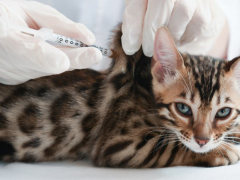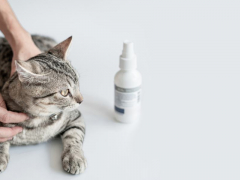
Vectra is a brand of topical, “spot-on” flea treatment and prevention product manufactured by Ceva Animal Health. In this article, you’ll learn what Vectra is, its active ingredients and how they work, the parasites it targets, adverse effects to watch for, and some frequently asked questions.
Vectra for Cats & Kittens Overview

About Vectra for Cats
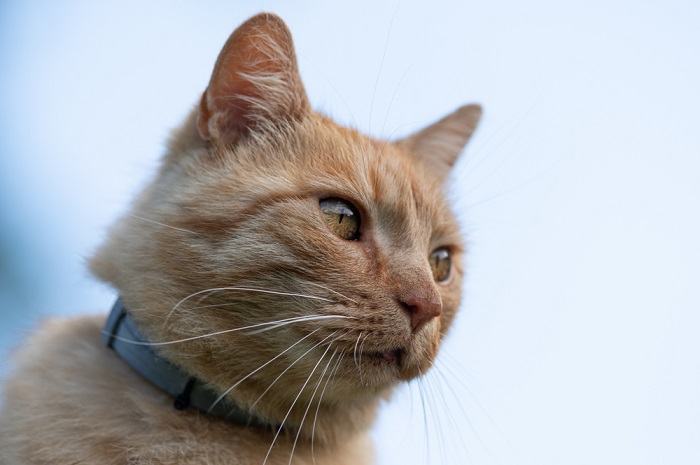
Vectra for cats contains the two ingredients dinotefuran and pyriproxyfen.
Dinotefuran is a nitroguanidine neonicotinoid insecticide. It binds to the neurotransmitter acetylcholine receptor on target insects leading to overstimulation. This causes tremors, incoordination, and death of the insect. It’s important to note that dinotefuran only binds to insect acetylcholine sites, and not to similar feline receptor sites.
Pyriproxyfen acts as an insect growth regulator. By mimicking and pretending to be insect juvenile growth hormone, it halts development of flea larvae. It also leads to a female flea producing non-viable eggs that cannot hatch.
Spot-on products like Vectra are applied to the surface of a small target area or “spot” of the skin, usually at the back of the head or neck.
Medication collects in the oils of the skin and hair, allowing for continual release, lending to a 30 day period of efficacy. For many topical products, it takes about 24 hours to spread throughout surface oils on skin and hair to provide complete protection.
It is important to note that while these pesky pests are affected by Vectra by coming in contact with the skin and don’t have to actually bite a kitty to die, Vectra products do not provide true repellency that would prevent fleas from coming in contact with a pet.
What Does Vectra Do for Cats?
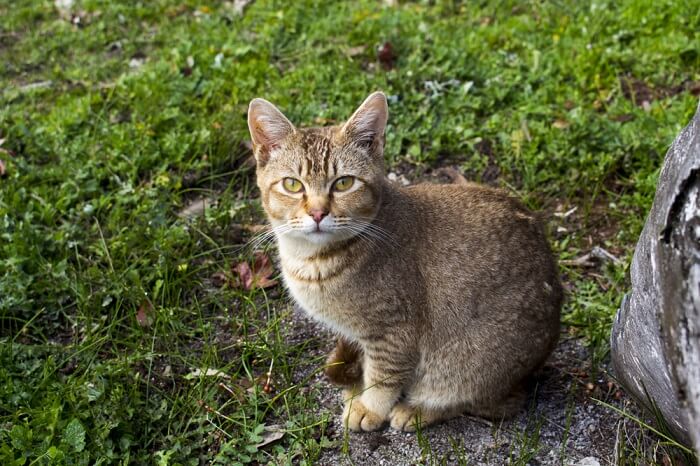
According to the manufacturer, Vectra is fast-acting for flea control, killing fleas quickly within six hours. The addition of the pyriproxyfen prevents continued reproduction and continuance of the flea life cycle. This eliminates re-infestation, as long as the product is continually used on a monthly basis.
It’s important to note here that Vectra only has activity against fleas and does not kill ticks, intestinal parasites, or mosquito-borne heartworms.
Vectra is quick-drying. Reportedly, bathing or swimming may not interfere with its action. However, generally, it’s an accepted practice to avoid bathing 24 hours prior to or 48 hours following the application of a product like Vectra.
Side Effects of Vectra for Cats
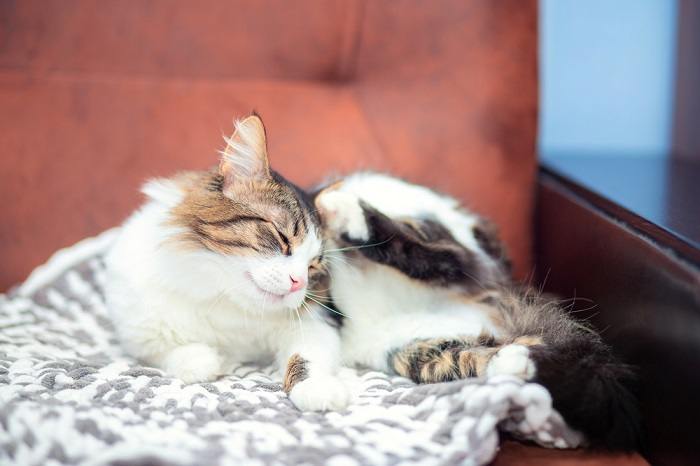
Monthly use of Vectra kills fleas and interrupts the flea life cycle to prevent new flea eggs from hatching.
According to the manufacturer, most adverse effects may be related to irritation at the application site, including redness, itching, and scratching. If you notice these effects in your cat after applying the product, the manufacturer recommends bathing with a mild soap or shampoo and rinsing with large amounts of water.
The manufacturer notes that gastrointestinal signs like vomiting and diarrhea have also been reported.
Both ingredients currently found in Vectra for Cats (dinotefuran, pyriproxyfen) generally appear to have a low potential for toxicity both topically and even if accidentally ingested.
However, most topical flea products are very bitter tasting. If a kitty were to lick off recently applied Vectra, either from themselves or a housemate, the bitter taste alone can lead to excessive drooling, agitation, and sometimes even vomiting.
According to DVM360, this effect is typically not a true toxicity, but a sometimes dramatic reaction to the bitter taste. Providing milk or liquid from a can of tuna can help resolve the signs in short order.
To avoid this from happening, it is important to apply any topical flea/tick product to the skin in front of the shoulder blades at the back of the neck, a location even the most flexible cat cannot reach to lick. In multiple cat households where lots of co-grooming occurs, it may be advisable to separate housemate kitties for up to 24 hours after application to allow the product to fully dry.
Using Caution With Other Flea/Tick Products
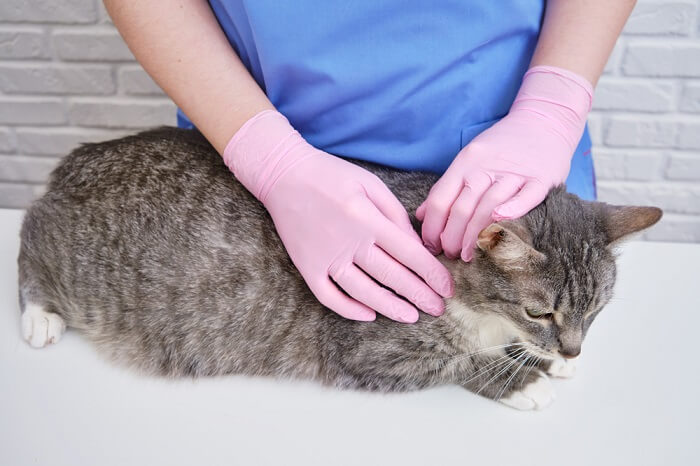
There is a very similar product for dogs called Vectra 3D. It is extremely important to never use this product on a cat.
Vectra 3D does contain two of the same ingredients as Vectra for Cats (dinotefuran and pyriproxyfen), but it also contains permethrin, which is very toxic to cats.
Fortunately, the Vectra 3D products do include a warning against use in cats on the front of the box.
But as a general guideline and just to be safe, when selecting a flea/tick product for your kitty, always make sure the product includes a picture of a cat and indicates the product is specifically for cats. This is now a requirement manufacturers have to follow to reduce the chance of mistaken product identity.
If possible, avoid use of any permethrin product on your dog at home if you have one cohabitating with your kitty.
If you must use a permethrin product and you have a pup and kitty who like to hang out together or groom each other, make sure to separate them for 24 to 48 hours after applying a topical product to your dog.
If you have any concerns for potential toxicity, even if you think your kitty might have just licked some Vectra off her own fur and is having a bitter taste reaction, it is always best to contact your veterinarian, the ASPCA Animal Poison Control Center (1-888-426-4435), or Pet Poison Helpline (1-855-764-7661) immediately for further advice.
And lastly, topical products like Vectra have been known to cause skin and eye irritation in people. It is best to avoid contact with the solution during application and to wash your hands after.
Vectra for Cats Dosage
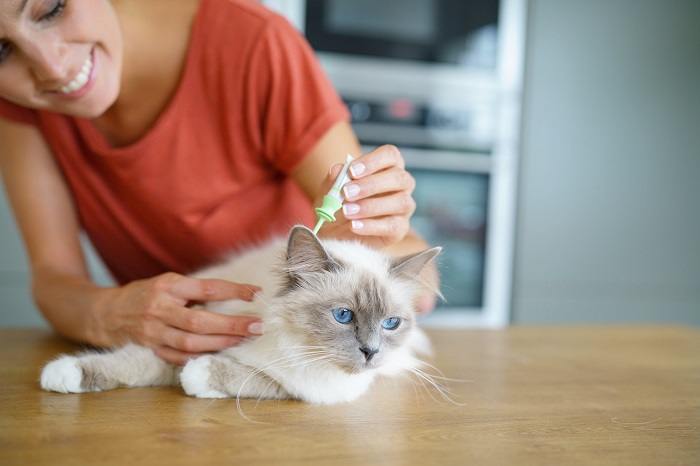
Apply Vectra to the skin in front of the shoulder blades at the back of the neck where your cat cannot lick it off.
Vectra products are typically applied every 30 days for the best protection.
Vectra comes in two sizes for kitties. The first is Vectra for Cats and Kittens, which is indicated for felines weighing 2 to 9 pounds and at least 8 weeks of age or older. The second is Vectra for Cats, which is indicated for kitties weighing over 9 pounds.
Always follow all instructions on the packaging for any topical product you use for your kitty. Vectra vials come with a very narrow applicator tip with a small discoid base. Below the discoid base is another, larger, disc. To activate the vial, push the small disc at the base of the tip down so that it is in contact with the larger disc below it.
Vectra is then best applied as a topical treatment by parting the fur and applying to the skin along the back of the neck in front of the shoulders where a kitty cannot reach to lick it off.
Again, while Vectra reportedly is fast-drying and not affected by bathing, it’s still advisable to make sure not to bathe your kitty for 24 hours before and 48 hours after an application of any topical product. Bathing shortly before application may reduce its effectiveness.
If for some reason you are unsure if the product was administered correctly or whether all of it was applied, it is usually safest to not apply an additional dose.
If you have any questions about application or safety for Vectra products or any topical product, make sure to get in touch with your veterinarian.
Drug Dosing Disclaimer: We are only able to provide doses for medications that are FDA approved for use in cats and only as the label guidelines dictate. For medications that are used off-label we can only provide guidelines and safety information for use. Safe and appropriate dosing for off-label medications can only be determined by a primary care veterinarian.
We encourage you to work with your veterinarian to determine if a particular medication is appropriate for your cat. Changing or adjusting a dose for your cat on your own without consulting with a veterinarian can carry risk. We do not encourage use of medications prescribed for human use in pets without first consulting with a primary care veterinarian.
